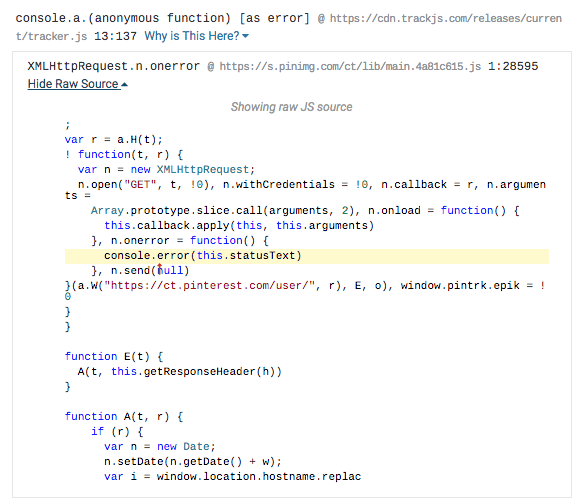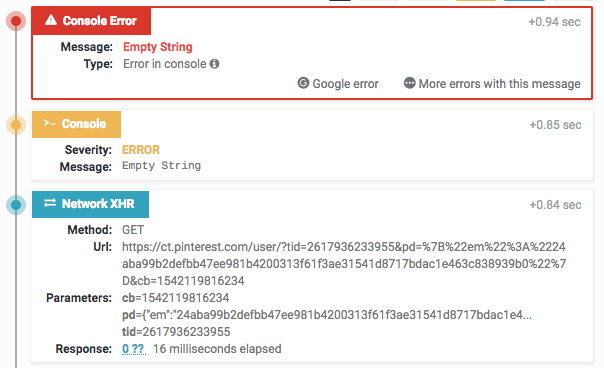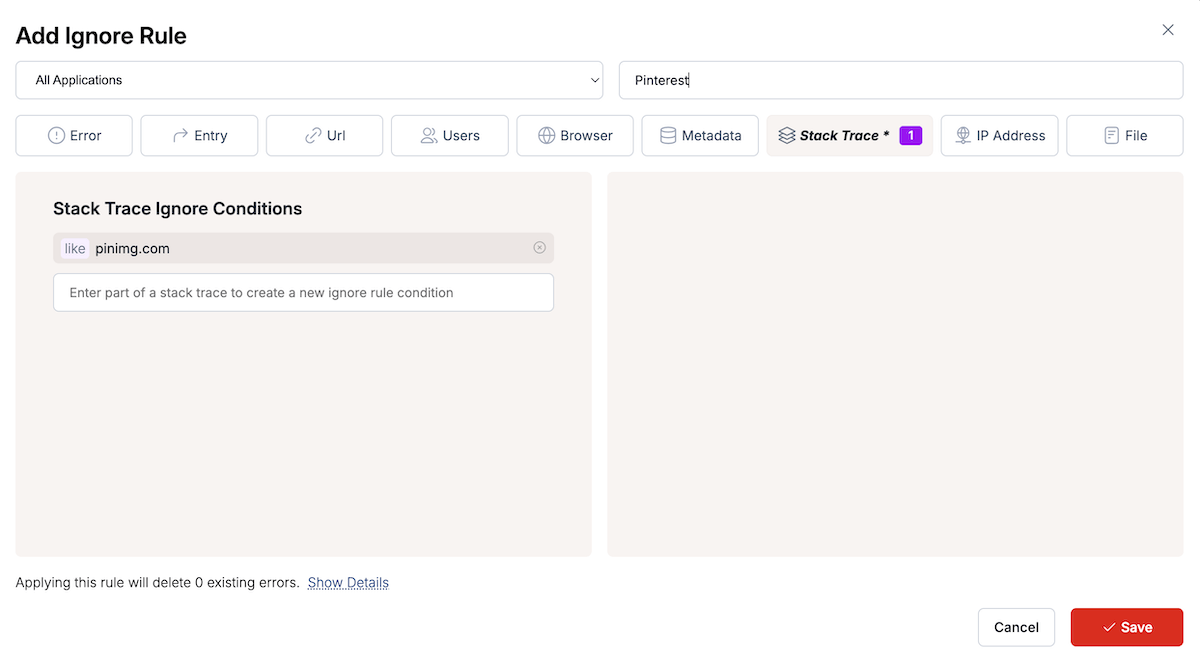An infuriatingly vague error message that leaves few clues about what’s going wrong. This empty string error appears when JavaScript libraries write blank error messages to console.error instead of meaningful descriptions.
The most common source of this error is the Pinterest widget library, which writes xhr.statusText to the console when network requests fail. When ad blockers prevent these requests, the status text becomes an empty string rather than a descriptive error message.
Important: This error typically represents ad blocker interference with third-party widgets, not problems with your application code.
The Problem
The empty string error manifests as "" passed into console.error, typically from third-party libraries that don’t handle network failures gracefully. TrackJS enriches these errors with stack traces showing where the empty message originated.
Investigation Story: A customer recently experienced large volumes of these empty string errors. Using TrackJS telemetry and stack traces, we tracked down the source to Pinterest’s widget library and ad blocker interference.
Stack Trace Analysis
The stack trace reveals the source of the empty string error:

The second frame of the stack points to s.pinimg.com where minified code makes an XMLHttpRequest to ct.pinterest.com/user/. When this call fails, the code writes xhr.statusText to the console - but if the request was blocked, statusText is empty instead of containing a descriptive message like “Not Found” or “Server Error”.
Network Telemetry Evidence
TrackJS network telemetry shows the Pinterest request completing with status code 0:

Status code 0 indicates the request was blocked by the browser or an extension - not a server error. Since there was no Content Security Policy blocking the request, the most likely cause is an ad blocker preventing requests to Pinterest’s domains.
Key insight: Ad blockers commonly block requests to social networks, analytics services, and advertising platforms like Pinterest, causing their error handling code to log empty strings.
Understanding the Root Cause
Empty string errors from Pinterest widgets occur when ad blockers interfere with the widget’s network requests:
1. Pinterest Widget Integration
Most common scenario: Websites integrate Pinterest “Save” buttons, follow buttons, or other widgets that make requests to Pinterest’s servers for functionality and analytics.
How to identify: Stack traces pointing to pinimg.com or pinterest.com domains with status code 0 network requests.
2. Ad Blocker Request Blocking
Ad blockers and privacy extensions frequently block requests to social media platforms like Pinterest, preventing the widgets from functioning normally.
How to identify: High volumes of empty string errors from users, particularly those using privacy-focused browsers or extensions.
3. Poor Error Handling in Third-Party Code
Pinterest’s widget code writes xhr.statusText directly to console.error without checking if the value is meaningful.
How to identify: The error occurs in third-party library code, not your application code.
4. Browser Extension Interference
Privacy extensions, social media blockers, and comprehensive ad blockers all commonly block Pinterest widget requests.
How to identify: Errors that don’t correlate with actual Pinterest functionality problems on your site.
How to Fix Empty String Errors
Quick Troubleshooting Checklist
- Verify the error originates from Pinterest widget code
- Check network telemetry for status code 0 requests to Pinterest
- Confirm your site works properly when Pinterest is blocked
- Set up error monitoring filters to ignore Pinterest-related errors
- Consider if Pinterest widgets are essential to your user experience
The primary “fix” is recognizing this as expected ad blocker behavior, not a site error:
Step 1: Verify Site Functionality Without Pinterest
Test your website with Pinterest blocked to ensure core functionality remains intact:
// Test your site with Pinterest blocked
// 1. Open DevTools → Network tab
// 2. Right-click → Block request domain
// 3. Add: *.pinterest.com, *.pinimg.com
// 4. Test your site functionality
Step 2: Configure Error Monitoring to Ignore Pinterest Errors
Set up ignore rules to filter out Pinterest-related empty string errors:

TrackJS ignore rule configuration:
- Message contains:
""(empty string) - File contains:
pinimg.com
// Programmatic filtering for Pinterest errors
TrackJS.install({
token: 'your-token-here',
onError: function(payload) {
// Filter based on stack trace
if (payload.message === '' &&
payload.stack && payload.stack.includes('pinterest')) {
return false; // Don't track Pinterest-related empty strings
}
return true; // Track other errors normally
}
});
Step 3: Consider Pinterest Widget Alternatives
Evaluate whether Pinterest integration is essential for your user experience:
// Alternative approaches to Pinterest integration
// Option 1: Simple share link (no JavaScript required)
// <a href="https://pinterest.com/pin/create/button/?url=YOUR_URL&description=YOUR_DESCRIPTION"
// target="_blank" rel="noopener">
// Save to Pinterest
// </a>
// Option 2: Conditional loading with error handling
function loadPinterestWidget() {
// Only load if user explicitly requests it
const script = document.createElement('script');
script.src = '//assets.pinterest.com/js/pinit.js';
script.async = true;
script.onerror = function() {
console.log('Pinterest widget failed to load - likely blocked');
// Show fallback sharing option
showFallbackShareButton();
};
document.head.appendChild(script);
}
function showFallbackShareButton() {
// Replace Pinterest widget with simple link
const pinterestButtons = document.querySelectorAll('[data-pin-do]');
pinterestButtons.forEach(button => {
button.innerHTML = '<a href="' + getPinterestShareURL() + '" target="_blank">Share on Pinterest</a>';
});
}
Step 4: Monitor for Pattern Changes
Track Pinterest error volumes to detect changes in ad blocker behavior or Pinterest widget updates. Error monitoring services like TrackJS help identify if Pinterest errors suddenly increase, which might indicate changes in the widget code or new ad blocker rules affecting your site.
While these errors should generally be ignored, monitoring trends helps understand the impact of third-party dependencies on your error rates.
When to Ignore This Error
Empty string errors from Pinterest should almost always be ignored because:
- Third-party code: Error originates from Pinterest’s widget library, not your code
- Ad blocker interference: Represents user choice to block social widgets
- No user impact: Pinterest blocking doesn’t affect core site functionality
- High noise: Can generate significant error volume without indicating real problems
However, investigate if you notice:
- Site functionality breaking: Pinterest blocking affects critical features
- User complaints: Users reporting missing Pinterest functionality they expect
- Revenue impact: Pinterest integration is essential for business metrics
Summary
Empty string errors are most commonly caused by Pinterest widget libraries when ad blockers prevent network requests to Pinterest’s servers. The widget code writes empty xhr.statusText values to the console instead of handling blocked requests gracefully.
The appropriate response is ensuring your site functions properly without Pinterest, then filtering these errors out of your monitoring system. These errors represent user choice to block social widgets, not problems requiring fixes.
Remember: Third-party widget errors are a normal part of the web ecosystem where users employ ad blockers and privacy tools. Focus your debugging efforts on errors that actually impact your application’s core functionality.


